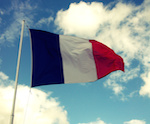If you really want to learn French, you need to know a few French expressions...
Si tu veux vraiment apprendre le Français, il faut connaître quelques expressions Françaises!
Fewer things are more revealing of a person’s familiarity with a language than utilising expressions to convey an idea. Unlike expletives, which many people use to add emphasis to a statement, a thoughtfully used expression is la meilleure façon (the best way) to convey your understanding of French that might surprise, and even impress, the unassuming listener.
Here are few more tournures de phrases (turns of phrase) worth adding to your repertoire. For previous posts on French expressions, see part 1, part 2 and part 3 by scrolling back in the blog pages.
NOTE: Phrase in parentheses is the literal translation, or as close to it as possible.
Peigner la giraffe (Painting the giraffe) – Not doing anything useful.
Battre la semelle (Beating the sole) – Walking and waiting.
Filer à l’anglaise (Getting away at the english) – Leaving without saying goodbye or without telling anyone.
L’habit ne fait pas le moine (The garment does not make the monk) – Appearances can be deceiving.
Faire un four (Doing an oven) – Being a failure at something.
Rouler quelqu’un dans la farine (Rolling someone in flour) – Lying to someone.
Avoir le cœur sur la main (Having the heart on the hand) – Being generous.
Tirer sur l’ambulance (Pulling on the ambulance) – Burdening someone who is already going through a difficult situation.
Couper les ponts (Cutting the bridges) – Severing relationships (similar to the expression “Burning one’s bridges”).
Salut vieille branche! (Hey old branch!) – You can use this expression with someone you’ve known a long time.
Tête de nœud (Head of knots) – Dummy/fool.
Tenir les murs (Holding the walls) – Not doing anything.
Au doigt mouillé (At the wet finger) – Imprecisely or only approximately.
Sur le fil du rasoir (On the string of the razor) – In a dangerous or unstable situation (similar to the English expression “On the razor’s edge”).
La tentation de Venise (The temptation of Venice) – Tempted to devote your time to something else, to change vocations.
Faire flanelle (Doing flannel) – Not purchasing or consuming anything.
Le diable est dans les détails (The devil is in the details) – Remembering that details are important and not to disregard them (this expression is found in the English language and is very common).
Couper la poire en deux (Cutting the pear in two) – Splitting something equally or compromising.
La loi de la jungle (The law of the jungle) – The law of the strongest.
Rester sur l’estomac (Staying on the stomach) – Referring to something that is difficult to digest.


Blog submitted by: David at The French Property Network - Cle France.
This blog was originally posted on The French Language Blog pages.